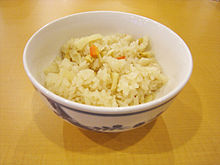Takikomi gohan

Takikomi gohan (炊き込みご飯, 炊き込み御飯) is a Japanese rice dish seasoned with dashi and soy sauce along with mushrooms, vegetables, meat, or fish. The ingredients of takikomi gohan are cooked with the rice; in a similar preparation, maze gohan (混ぜ御飯), flavorful ingredients are mixed into cooked rice.[1] In the kansai region, Takikomi gohan is called Kayaku gohan, and in Okinawa, it is called Jucy.[2] This dish is consumed by people in Japan around the fall season since a lot of root vegetables and mushrooms are harvested during this season in Japan.[3] Ingredients will vary based on the seasonal vegetables and fish. Since this dish covers a lot of nutritional facts, and substitutes a partial amount of rice from a serving size with vegetables and proteins, thus some Japanese people eat it for dieting purposes.[4] One of the reasons why this dish is very popular in Japan is because it is easy to make and does not require a lot of equipment to prepare.
Variations
- Tai-meshi (鯛飯): rice with whole sea bream [5]
- Ayu-meshi (鮎飯): rice with whole sweetfish
- Matsutake gohan (松茸御飯): rice with matsutake mushrooms
- Kani-meshi (蟹飯): rice with crab
- Gomoku meshi (五目飯 or gomoku gohan 五目御飯): loosely translated, "five ingredients mixed rice," whose contents often revolve around seasonal availability and can include matsutake or shiitake mushrooms, bamboo shoots, burdock root, fresh soybeans, chestnuts, chicken, firm white-fleshed fish, or oysters.[6] In the Osaka dialect, this dish is called kayaku gohan (加薬御飯).[7]
See also
- Arroz con Pollo, Arroz con gandules, Platillo Moros y Cristianos, Gallo Pinto, Pabellón criollo, Rice and beans (Latin America)
- Biryani (South Asia)
- Fried Rice (East Asia)
- Jambalaya (Louisiana)
- Jollof rice (West Africa)
- Hoppin' John (Southern United States)
- Kabsa (Saudi Arabia)
- Kedgeree (United Kingdom)
- Kushari (Egypt)
- Nasi Goreng (Indonesia)
- Paella (Spain)
- Pilaf/Pulao (Greece, Balkans, Turkey, Iran, Central Asia, South Asia)
- Rice and peas (Caribbean)
- Risotto (Italy)
- Spanish rice (Mexico)
Notes
- ^ Tsuji, Shizuo. Japanese Cooking: A Simple Art. Kodansha International. 2006, p. 276.
- ^ Aniwotawiki. (2020, October 29). 炊き込みご飯 - アニヲタWiki(仮)【10/29更新】. Retrieved October 30, 2020, from https://w.atwiki.jp/aniwotawiki/pages/4126.html
- ^ 9月に美味しい旬の野菜. (n.d.). Retrieved November 05, 2020, from https://foodslink.jp/syokuzaihyakka/syun/monthly/septembre-ve.htm
- ^ Watanabe, A. (2020, October 05). 炊き込みご飯のカロリー・糖質は?白米よりダイエット向きな理由は?. Retrieved November 05, 2020, from https://chisou-media.jp/posts/598
- ^ Tsuji, Shizuo. Japanese Cooking: A Simple Art. Kodansha International. 2006, p. 277.
- ^ Tsuji, Shizuo. Japanese Cooking: A Simple Art. Kodansha International. 2006, p. 278.
- ^ Tsuji, Shizuo. Japanese Cooking: A Simple Art. Kodansha International. 2006, p. 278.
References
- Hosking, Richard. A Dictionary of Japanese Food: Ingredients & Culture. Tuttle Publishing, 1997, p. 46
- Tsuji, Shizuo. Japanese Cooking: A Simple Art. Kodansha International. 2006, p. 278.
